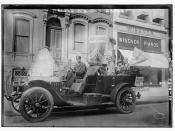Young Goodman Brown is written as a journey of internal conflict, where Brown is oblivious to his role and sins. This work contains wicked and evil components, and Nathaniel Hawthorne leaves Brown hopeless and disconnected in his life. Hawthorne does not allow Brown to rise above his fears and leaves Brown incognizant of what he is doing. Hawthorne uses subtle symbolism and foreshadowing throughout his story providing many layers and levels at which the story can be interpreted.
Within the first few paragraphs Hawthorne informs his readers of the religious elements he intends to address. For example, the "aptly named" wife of Goodman Brown, Faith is introduced. (667) Her name alone serves as a double meaning, one of which is simply that of which she is known and the other is that of an unquestioning belief in God that does not require proof or evidence. Hawthorne then stresses the importance of the pink ribbons in Faith's hair that "play" in the wind, symbolizing Faith's childlike innocence and purity.
(667) The foreshadowing takes place through the first dialogue between Brown and his wife. She warns him of her dreams and thoughts which plague her and begs for him to stay the night and leave on his journey in the morning, but he insists on leaving and questions her faith in him. As he starts his journey he begins to second guess his decision to leave his wife apprehensive and justifies his "present evil purpose" by vowing that "after this one night, [he'll] cling to her skirts and follow her to heaven". (667)
The foreshadowing technique is seen again shortly after Brown enters the dark and gloomy woods by nervously stating, "What if the Devil himself should be at my very elbow!.", and within the following paragraph Brown meets up with what...
![[Portrait of Juan Tizol(?) and Lawrence Brown(?), Aquarium, New York, N.Y., ca. Nov. 1946] (LOC)](https://s.writework.com/uploads/7/77189/portrait-juan-tizol-and-lawrence-brown-aquarium-new-york-n-thumb.jpg)

